Note: This website was automatically translated, so some terms or nuances may not be completely accurate.
Characteristics of "People Who Enjoy Twitter While Watching TV" as Observed from the "M-1 Grand Prix"

Kenichiro Sato
Twitter Japan Inc.
The M-1 Grand Prix is a major annual year-end event.
This program, which sees thousands of entries each year (a record 5,081 in 2020) and crowns Japan's top manzai act, attracts attention annually not only for the finalists' signature routines and the question of "Who will be this year's champion?" but also for the harsh comments delivered by the judges.
Many people watch it live on TV; the 2020 real-time average viewership rating was 19.8% (Video Research Ltd., Kanto region). It ranked 29th among all TV programs that year in terms of viewership.
This time, we present findings from a survey conducted among viewers of the "M-1 Grand Prix 2020" about "people who enjoy Twitter while watching TV." We gained several useful insights regarding the relationship between "TV and Twitter" that will inform future strategies.
With smartphones in hand, they share their excitement and emotions in real time
During the finals, Twitter overflowed with various voices: cheers for favorite comedians, reactions to judging results, and more.
Looking at the minute-by-minute trend of tweets during the broadcast, we observed a tendency for tweet volume to spike immediately after each finalist's performance ended or right after the judges' comments, suggesting viewers were using Twitter while watching TV. This also revealed that many people were sharing their excitement and emotions in real time through Twitter.
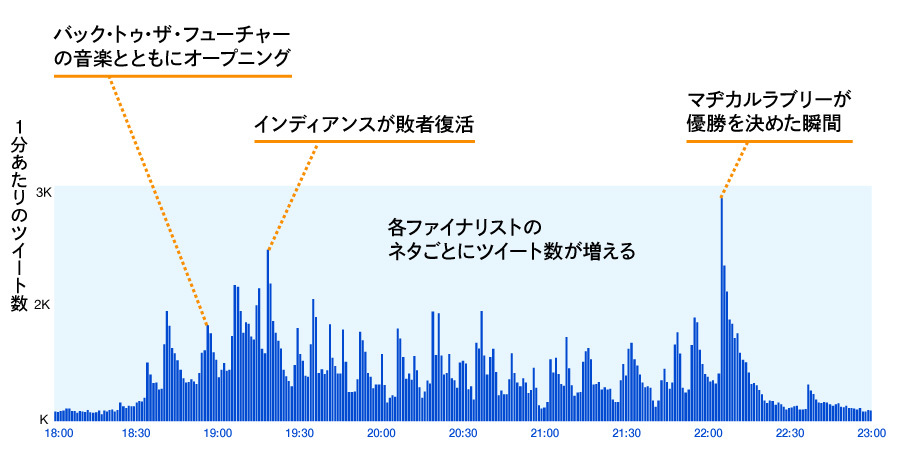
An online survey of viewers of the "M-1 Grand Prix 2020 (Final)" residing in the Tokyo metropolitan area (defined as those who watched more than half of the program) revealed that 64% of respondents used Twitter.
Among online media, "It was trending on Twitter" ranked first as the reason for deciding to watch the program. Notably, among viewers in their teens and twenties, the number of people who watched the program because of Twitter was overwhelmingly higher compared to other media. This suggests that many viewers became interested after encountering information about the program on Twitter.
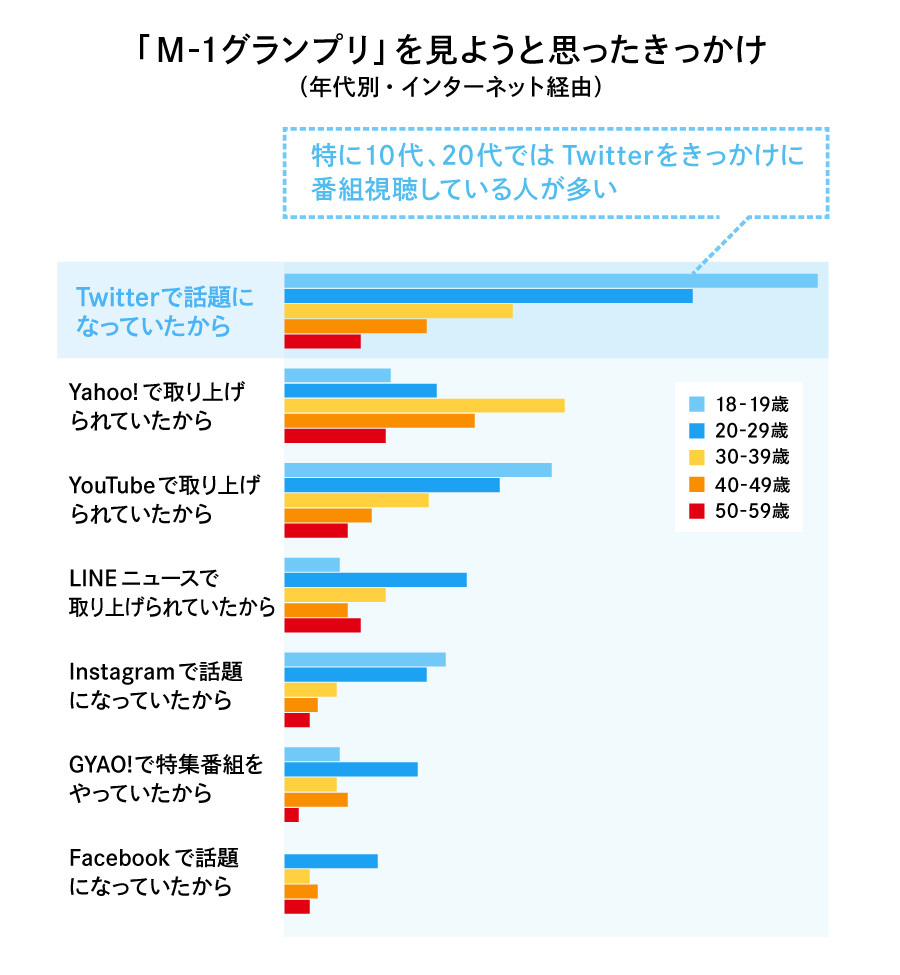
Twitter users significantly outpace non-users in "level of enthusiasm" for the program
Looking at the "level of enthusiasm" (how hooked they were) for the "M-1 Grand Prix 2020," comparing those exposed to tweets (people who encountered related tweets on Twitter) with non-users, the scores were consistently higher for those exposed to tweets.
For example, those who felt "I was on the edge of my seat wondering who would win until the very end" were 1.5 times more likely to be Twitter users than non-users. Furthermore, Twitter users were overwhelmingly more likely to express a desire to communicate with others about the program, such as "I started having lively conversations with family or friends about the show" or "I felt like talking to someone about the program's content or my impressions."

Investigating the Actual Behavior of People Enjoying Twitter While Watching TV Using Brainwave Measurement
We also conducted a survey utilizing home-based neuro-research (*1) developed by Dentsu ScienceJam Inc. for viewers of the "M-1 Grand Prix 2020."
*1 An affective evaluation system utilizing Dentsu ScienceJam Inc.'s proprietary "affect measurement technology via EEG." Measurement devices were distributed to participants' homes. Participants enjoyed TV in a relaxed state at home while EEG data was collected in real-time. Data was analyzed on a dedicated server.
We distributed dedicated measurement devices to two groups of monitor households in the Tokyo metropolitan area and conducted a comparative experiment to observe the effects on viewers' brainwaves during the "M-1 Grand Prix 2020."
・Group watching only the TV program
・Group enjoying Twitter while watching TV programs (e.g., using the hashtag "#M1GrandPrix")
Analysis of brainwaves during program viewing revealed that the "group watching TV while enjoying Twitter" experienced higher "satisfaction" with the program and lower "stress levels" compared to the "group watching only the TV program."
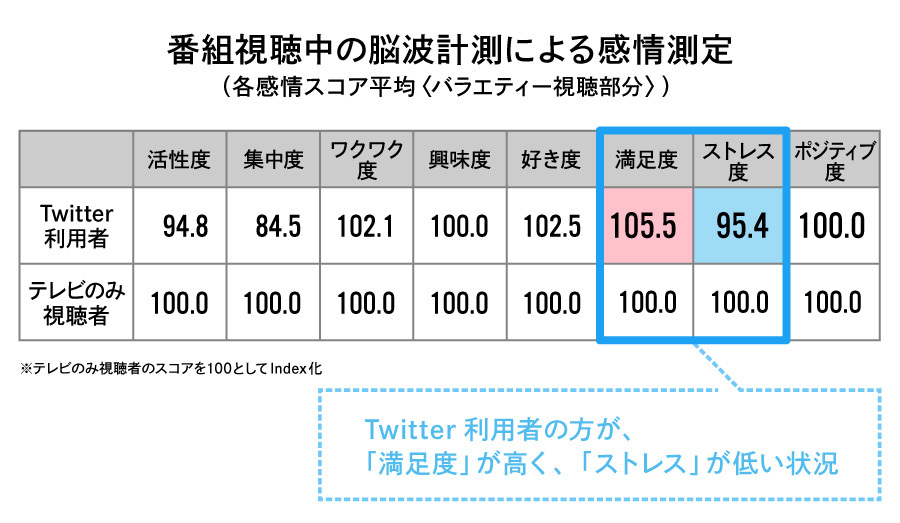
When examining emotions minute-by-minute through brainwaves, Twitter users showed higher "satisfaction" than the group watching only the TV program during nearly all time periods and scenes.
While it has been noted before that "watching TV while using Twitter enhances enjoyment of the program," this trend was clearly highlighted once again through EEG measurement in this study.
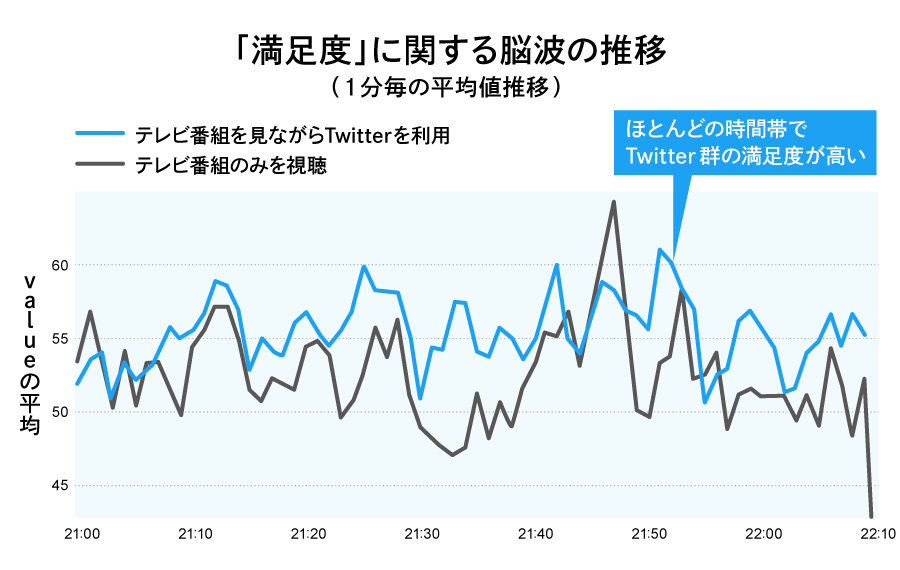
We also analyzed neuro-research data for commercials aired during the program. The results showed that even while watching commercials, Twitter users experienced higher levels of "excitement" and "satisfaction" while feeling lower "stress."
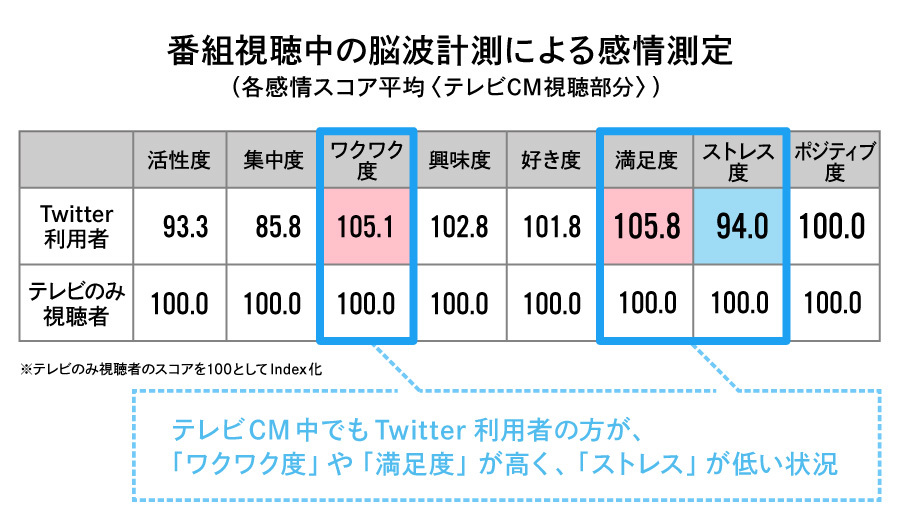
This is likely due to the fact that some TV commercials featured performers from the show, which became a hot topic on Twitter, and that Twitter users with high enthusiasm for the program were more receptive to "advertising expressions linked to the content."
In our previous article, we introduced survey results from viewers of last year's hit drama "Hanzawa Naoki." There, we also reported that the "group who enjoys Twitter while watching TV programs" showed high enthusiasm for the program and positively received commercials aired during the broadcast.
"Hanzawa Naoki" achieved a real-time average viewership rating of 32.7% (Video Research Ltd., Kanto region) for its finale, and a total viewership rating (combining real-time and time-shifted ratings, with duplicates counted once) of 44.1%. Both figures rank it as the top drama program in the Reiwa era.
Given its exceptionally high ratings compared to other TV programs, we initially thought the aforementioned TV×Twitter effect might be unique to "Hanzawa Naoki" viewers. However, our investigation of the "M-1 Grand Prix 2020" revealed that similar effects occur with popular variety shows as well.
Twitter ads linked to TV program content significantly boost ad awareness
Concurrently with the above survey, Dentsu Inc. attempted to verify the effectiveness of Twitter ads using STADIA, developed by Dentsu Inc. with the cooperation of Dentsu Macromill Insight, Inc.
STADIA is a solution that integrates data from offline media, such as terrestrial broadcasts, with online media data from smartphones and PCs. It enables digital ad delivery and integrated analysis of online and offline media by matching viewing log data from approximately 7.4 million TVs (as of February 2021) with device data (smartphones/PCs) from the same viewing environment.
By utilizing STADIA, we could survey users who actually watched the "M-1 Grand Prix 2020" on TV, yielding results closer to the actual situation.
The survey asked the following two groups about campaign awareness and attitude changes, among other things (*2).
1. "TV Viewing + Twitter Ad Exposure" Group
2. "TV Viewing Only" Group
*2 Twitter ad exposure was determined through awareness surveys.
We measured ad awareness for multiple brands that aired TV commercials during the "M-1 Grand Prix 2020" program and also ran pre-roll ads (Twitter IVS ads) on Twitter before the program started, promoting content linked to the show.
This Twitter advertising campaign featured popular comedians incorporating advertised products into their routines, creating infomercial-style content that was truly integrated with the program.
The survey results revealed that ad awareness for "TV viewing + Twitter ad exposure" was approximately six times higher than for "TV viewing only." It is believed that viewers who watched the program on TV and also saw the program-linked ads on Twitter experienced a significantly higher impact on ad awareness.

This time, we examined the actual behavior of people who simultaneously enjoy TV and Twitter, along with the advertising effectiveness of "TV × Twitter" visible from this behavior, using multiple approaches including neuro-research and STADIA-based effectiveness measurement. These findings clearly show that Twitter campaigns linked to TV programs can achieve higher effectiveness.
Next time, we will explore the potential of TV × Twitter in campaigns from an "advertising planning" perspective.
Was this article helpful?
Newsletter registration is here
We select and publish important news every day
For inquiries about this article
Author

Kenichiro Sato
Twitter Japan Inc.
Marketing Insights & Analytics Team
Senior Research Manager
After working as a researcher at a domestic think tank and a foreign research firm, joined Twitter Japan in 2016. Primarily conducts insight-driven research and analysis, including campaign effectiveness measurement, branding surveys, and user behavior analysis.
